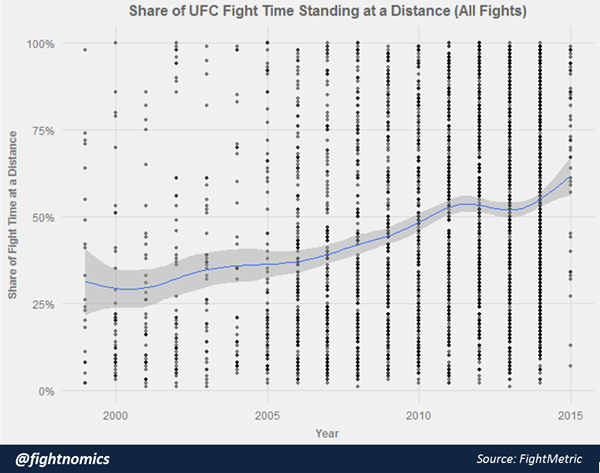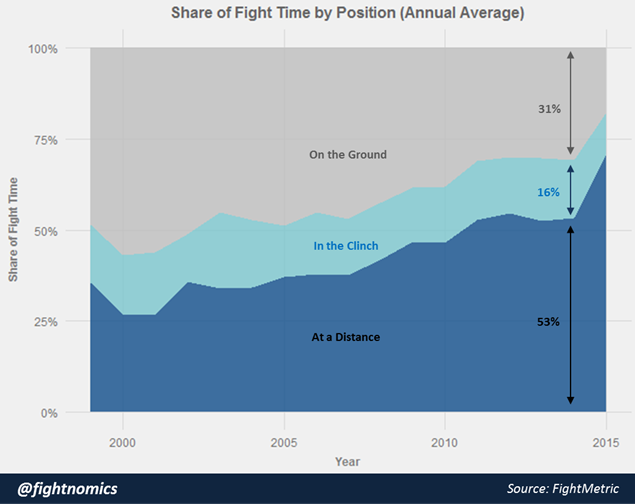By @fightnomics We have already seen a brief history of the UFC by the fights they promoted, and how they ended. But what about more subtle ways in which MMA has evolved over time? Are fighters fighting any differently now than they once did? We often hear that wrestlers are altering the competitive dynamics of the sport at its core, or worse, making it “boring.” The infamous Junie Browning of TUF Season 8 lamented the performance of “boring ass wrasslers,” and plenty of fans at live events are vocal with their displeasure if fights spend too much time on the ground. But are MMA fights really spending too much time on the ground? Are wrestlers making MMA boring? Let’s simply consider how UFC fights have changed through the years by how much time each fight spends standing versus in other positions. First, let’s take every fight for which there is Time in Position data and plot each one by year with what percentage of the fight time was spent standing and trading at a distance. That means we see a single point from 0% to 100% representing how much time fighters were not clinching or on the ground. It’s a busy chart, so are a few things to clarify. There are obviously a lot more fights with each passing year, so many more dots littering the vertical for each column. The points are actually grayish, semi-transparent dots, so dark black means numerous points overlapping. And since the density of fights increases and patterns would be hard to discern, a blue trendline has been overlaid to show the trend over the years.  For more details on these and other MMA performance metrics, get the book “Fightnomics.” So what this data is telling us is that fights in the UFC are averaging more time standing and trading at a distance as time goes on. In fact, fighters in today’s UFC average nearly twice the time striking from a distance as they did in first few years. It’s a strong upward trend, but obviously one that can’t continue forever. There is of course an upward limit, and while a variety of stylistic, competitive, and even size factors changing over time have influenced to overall trend, the net result is that we’re spending more time watching fighters go toe-to-toe than ever before. So if wrestlers are ruining the sport, they’re not doing so by actually using their wrestling. As with our fight ending chart, it’s helpful to see how fights go down by position as a proportion of the total fight time on average. Fighters are always start a fight by standing at a distance, but apparently their tendency or ability to take things to the ground is decreasing and years go on. In 2014, a total of 69% of all Octagon time saw two fighters on their feet at a distance or in the clinch, while only 31% of the time was actually spent on the ground. The data from 2015 is very incomplete, so before we can confirm a continuing upward trend, we’ll give it a few more months. The early months of the year saw a sharp increase in the time standing at a distance, which will be revisited later.
For more details on these and other MMA performance metrics, get the book “Fightnomics.” So what this data is telling us is that fights in the UFC are averaging more time standing and trading at a distance as time goes on. In fact, fighters in today’s UFC average nearly twice the time striking from a distance as they did in first few years. It’s a strong upward trend, but obviously one that can’t continue forever. There is of course an upward limit, and while a variety of stylistic, competitive, and even size factors changing over time have influenced to overall trend, the net result is that we’re spending more time watching fighters go toe-to-toe than ever before. So if wrestlers are ruining the sport, they’re not doing so by actually using their wrestling. As with our fight ending chart, it’s helpful to see how fights go down by position as a proportion of the total fight time on average. Fighters are always start a fight by standing at a distance, but apparently their tendency or ability to take things to the ground is decreasing and years go on. In 2014, a total of 69% of all Octagon time saw two fighters on their feet at a distance or in the clinch, while only 31% of the time was actually spent on the ground. The data from 2015 is very incomplete, so before we can confirm a continuing upward trend, we’ll give it a few more months. The early months of the year saw a sharp increase in the time standing at a distance, which will be revisited later.  Whether or not wrestlers are changing the sport of MMA can be argued from a number of angles. But one this is for sure: fights are not spending more time on the ground these days, not by a long shot. It could be that takedown defense has improved over the years due to the competitive threat presented by strong wrestlers. Or it could be that fighters are simply not looking to take the fight down as often as they once did for other reasons, like fan-perception. The boo-birds or conceivably the reactions of promoters to fighters who like to spend too much time on the ground without mounting much offense may be changing the behaviors of the athletes seeking higher promotion. Or maybe fighters are able to get up from a takedown better than before. Possibly referees are also influencing these in-fight trends. We’ll examine some of these potential causes soon, but consider the idea that wrestlers are ruining MMA to be busted from the start. For information on getting the “Fightnomics” the book, go here.
Whether or not wrestlers are changing the sport of MMA can be argued from a number of angles. But one this is for sure: fights are not spending more time on the ground these days, not by a long shot. It could be that takedown defense has improved over the years due to the competitive threat presented by strong wrestlers. Or it could be that fighters are simply not looking to take the fight down as often as they once did for other reasons, like fan-perception. The boo-birds or conceivably the reactions of promoters to fighters who like to spend too much time on the ground without mounting much offense may be changing the behaviors of the athletes seeking higher promotion. Or maybe fighters are able to get up from a takedown better than before. Possibly referees are also influencing these in-fight trends. We’ll examine some of these potential causes soon, but consider the idea that wrestlers are ruining MMA to be busted from the start. For information on getting the “Fightnomics” the book, go here.